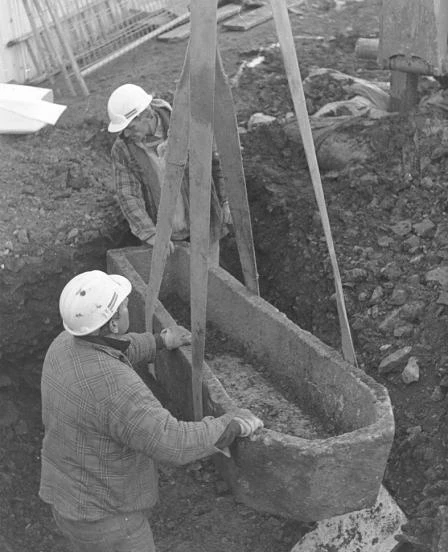The Undy Roman coffin
The Undy Coffin during excavation in 1996. The coffin was donated to Amgueddfa Cymru by David Mclean Homes Ltd.
The Undy Coffin being raised for transportation.
Inside surface of the coffin showing the tool marks of a pick and mason's point. Image © G. Lock.
The Undy Coffin.
In the 3rd or 4th century AD a young woman was buried in a stone coffin at Undy, Monmouthshire. 1600 years later her grave was rediscovered.
In 1996 workmen unearthed a coffin while digging foundations for new houses at Undy, Monmouthshire. Following their discovery the site was investigated by archaeologists, but it remains uncertain whether this was a lone burial of part of a small cemetery.
The coffin contained the skeleton of a young, right handed, adult, probably female, aged between 25 and 34 years old. The cause of her death is unknown, but radiocarbon dating revealed she was buried in the late 3rd or 4th century AD - when the Romans occupied Wales.
Although no grave goods were found, her burial suggests that she was a relatively wealthy woman, someone who could afford a stone coffin and a proper burial.
Burial rather than cremation
Burial in this manner had not always been the norm in Roman society. Until the late 2nd century AD most people were cremated; their ashes often being buried in a glass or pottery vessel. However from this time burial traditions began to change. New ideas about the afterlife required that the body be buried 'intact'. These ideas were due to influences from the eastern part of the Empire, including the rise of Christianity, with belief in bodily resurrection.
The coffin was an optional feature. The poor might be buried in a grave without a coffin. Coffins were produced in a range of materials including wood, lead and stone.
The Undy Coffin is made of Bath Stone, a light creamy coloured limestone which is soft and easily worked when first quarried, but hardens on exposure to the air. This stone is found in the region around the spa town of Bath, England (known to the Romans as Aquae Sulis, which translates as "The Waters of Sulis"). This area is some 20 miles (35km) south-east of Undy.
The Roman stonemasons who made it used a very similar range of tools to their modern counterparts. The surface of the Undy coffin preserves these toolmarks, including those made by adze-hammers, chisels, picks and masons points. The direction of the toolmarks indicates that the mason was left-handed.
Background Reading
"Tools and Techniques of the Roman Stonemason in Britain" by T. F. C. Blagg. In Brittania, vol. 7, p152-72 (1976).
"Stone Coffins of Gloucestershire" by R. N. Willmore. In Transactions of the Bristol and Gloucester Archaeological Society, vol. 61, p135-77 (1939).



